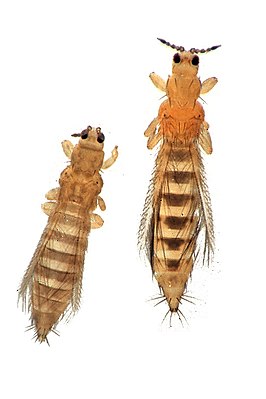Tobacco bladder
| Tobacco bladder | ||||||||||||
|---|---|---|---|---|---|---|---|---|---|---|---|---|

Tobacco foot (left) and Frankliniella occidentalis |
||||||||||||
| Systematics | ||||||||||||
|
||||||||||||
| Scientific name | ||||||||||||
| Thrips tabaci | ||||||||||||
| Lindemann , 1889 |
The Tabakblasenfuß ( Thrips tabaci ), also known as Zwiebelthrips or Tabakthrips known, a up to a millimeter-long insect from the order of the thrips . By sucking, it causes white patches on, among other things, tobacco, cabbage and potato plants. The species is distributed worldwide. However, it occurs less frequently in more humid areas, such as the tropics.
features
The females of the tobacco bladder foot have only receded wings . Their color varies from yellow to dark brown, while the smaller males are yellow. The forewings are bright and the main vein is covered with two to six bristles. There are 15 bristles on the side vein. The pinpoint eyes (ocelles) are usually gray, but never red, and there are two pairs of ocellar bristles. The third pair is smaller and is just in the Ocellen triangle. The antennae consist of seven members, the seventh member being shorter and the third and fourth members having a short forked sensory cone . The head is shorter than it is wide. For representatives of the Thripidae, the tobacco bladder foot has an extremely long tentotium bridge and extremely long anterior tentorium arms. On the tergite II, like on the sternites III to VII, there are three additional bristles on each side. There are two bristles on Sternit II. The abdominal ganglia complex is fused with the metathoracic ganglion.
Way of life
Laboratory research has shown that tobacco bubble feet prefer white, yellow, and blue areas. They feed on phytophagus , but can also become predators in situations of deficiency . The selection of the food plants is not yet exactly known. From experiments in the laboratory one concludes that any plant that is non-toxic is used as food.
The eggs are deposited in the leaf tissue. However , one leaf side is not preferred , as is the case with representatives of the genus Retithrips , for example . The embryonic phase lasts six days. Two larval and two nymph stages are passed through to the imago . The larvae are not nearly as demanding as those of Frankliniella occidentalis in terms of humidity . The animals overwinter in a temperature-controlled quiescence . The overwintered individuals are significantly darker than the summer individuals.
Enemies
Tobacco bladder feet are attacked by Beauveria bassiana , Metarhizium anisopliae , Neozygites parvispora , Zoophthora radicans and Entomophthora thripidum . A successful defense strategy against mites such as Amblyseius cucumeris has been observed using anal secretions.
Harmful effect
The species occurs in many varieties, depending on the forage plant. In Europe, Africa, Asia and Australia, for example, it is considered a pest on cotton plantings , while in Peru it occurs as a pest primarily on olive trees . In Germany, the tobacco bladder is the dominant thrip species in viticulture and in the cultivation of allium species such as onions, leeks, echallots and garlic.
The species also acts as a pollinator , for example in sugar beet .
supporting documents
Individual evidence
- ^ G. Crüger et al .: Plant protection in vegetable growing , 4th edition, Ulmer Verlag, Stuttgart, 2002, pp. 137-140, ISBN 88-506-5296-8
literature
- Moritz, Gerald: Thrips . Die Neue Brehm-Bücherei Vol. 663. Westarp Sciences, Hohenwarsleben 2006, ISBN 3-89432-891-6